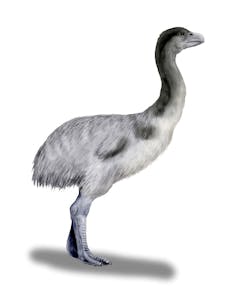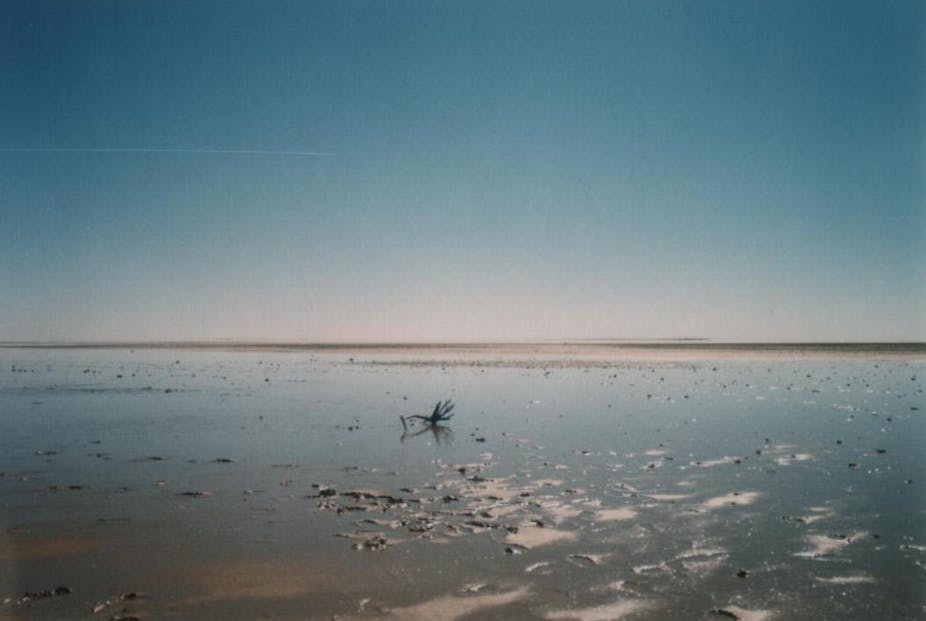Events some 40,000 to 60,000 years ago marked a critical juncture in the Australian continent’s history. This is when humans first arrived and also the time when many huge beasts, known as megafauna, seem to have disappeared. So what caused their demise: humans, a changing climate, or both?
The debate has been both long and polarised. Some blame changes in the prehistoric climate; others point to overhunting by the first Australians, or habitat burning by humans which drastically altered the landscape.
The “human-mediated” explanations depend to an extent on the climate having remained stable over the period in question. But we have found evidence that gigantic lakes in central Australia were drying out at the time – a crucial new climate factor that probably hastened the megafauna’s demise.
A watery world
Our research shows that before about 50,000 years ago, much of Australia’s interior was a very different place to the scatter of salt-crusted lakes and sand ridges seen today. By analysing ancient shorelines fringing Lake Eyre and Lake Frome, two of Australia’s largest inland lakes, we found evidence of a “time of plenty”, when perennial inland rivers fed huge, permanent mega-lakes.
The scene probably featured more vegetation than today, large herbivores and diverse aquatic ecosystems spanning hundreds of kilometres of teeming estuaries and rivers. Lake Eyre itself stood 25 m deep and with a volume of some 380 cubic kilometres (roughly 700 Sydney Harbours).
These inland mega-lakes were fed by big rivers such as Cooper Creek and the Diamantina River, which pumped large volumes of water into the continental interior every year to fill the lakes to the levels shown by the position of their ancient beaches. Mega-Lake Eyre held roughly ten times the water volume achievable under today’s wettest climate, and if present now would rank among the ten largest lakes (in area) on Earth. This truly was the inland sea that proved so elusive to Charles Sturt and other 19th-century colonial explorers.

Surely, too, it was not a bad place to live for the giant but now extinct bird, Genyornis newtoni, whose eggshell fragments are scattered across the lake shore, and indeed over much of Australia. By analysing such eggshells, as well as those of emus, researchers have previously reconstructed the dietary preferences of both species over the past 140,000 years. They found evidence of a drastic shift between 50,000 and 45,000 years ago, and reasoned that newly arrived fire-wielding humans altered the vegetation in a way that suited emus and not Genyornis, which then disappeared.
But that was before the discovery of the catastrophic drying phase, which was recorded at the same time in both of the lakes we investigated. We found that the environment was already changing by the time the first Australians arrived. The overflowing mega-lakes of pre-50,000 years ago had begun to shrink, and reliable supplies of freshwater were in a state of collapse. This was a time of environmental upheaval, and the roots of the episodic boom-to-bust ecosystems that we see today.
As for the demise of Genyornis, we suggest a far simpler explanation: these giant birds were unable to adapt to the loss of huge expanses of lakeshore and riverine habitat, coupled with the shift to dryland plants. The demise of the other megafauna is less precisely dated, but they too must have been affected by such a catastrophic environmental shift.

So was the arrival of humans on the continent at about the same time a contributing factor or coincidence? Our findings cast new perspective on events in Australia and bring climate change squarely into the timeframe — just as it has long been part of the debate in Eurasia and the Americas. Although direct evidence of people killing megafauna has not yet emerged in Australia, it may be only a matter of time before a big discovery is made. But of course, the argument for primarily human-driven extinction must rest on more than just coincident timing.
Climate change must now be considered a key factor in the Australian extinction debate. Credible new work will need to spell out how ecosystems adapted to shifting climate variability in combination with human impacts. As we point out in our paper, the global debate is moving away from single-cause explanations.
In light of our new findings, we hope that here too a more nuanced view will emerge regarding the interplay between Australia’s prehistoric climate, its first human inhabitants, and the demise of its megafauna.

